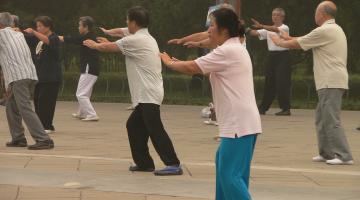Owatonna Chiropractor Gives Advice on Reducing Back Pain and Neck Pain
Working with patients every day has taught me two stark realities. The first is that most Americans have been systematically trained to believe that they are not capable of taking control of, building up, and regaining their health. The second is that there is a serious want for knowledge concerning exercises for the spinal column. Most people are aware of the benefits of doing bicep curls to help build the strength of the arms. What is less known is how to strengthen the deep muscles of the neck and lower back to regain lost strength. Building the strength of these muscle groups will help the neck and low back resist future injuries as well as increase the controlled movement of the spine so that greater functionality can be enjoyed. Many times, people can enjoy relief from chronic neck pain as well as chronic low back pain when using core strengthening exercises daily.
The movements that will be focused on are flexion and extension. Flexion is when you bend the spinal column forward. It’s the shape your spine assumes when you’re about to roll forward into a summersault. Extension is when you bend the spinal column backward. The shape your spine assumes when it’s in extension is how it moves when you first wake up in the morning and take your big stretch while arching your spine backwards.
Injuries to the neck from car crashes, car collisions, whiplash injuries, traumatic brain injuries, and blunt trauma can damage the muscles of the neck and cause a disconnect to form between the brain and the muscles of the neck. This creates what is known as an improper motor pattern. What we need to do is restore a proper motor pattern through consistent use of the previously damages muscles that have since become dysfunctional. The same improper motor patterning can occur in the low back region following injuries such as disc herniations, compression fractures, falls from great heights, work injuries, sports injuries, and slips on ice. The process is very similar when rehabbing the muscles of the low back through exercises.
Exercises For the neck:
1) Deep neck flexor endurance exercise
For this exercise you will begin by laying on your back on a comfortable surface. Next, you will tuck your chin into your chest without lifting your head up. You should feel a tight pinching contraction in the deep front muscles of your neck near your collarbone. After you have a good contraction started, you will lift your head up as minimally as possible. People often make a mistake by lifting their head up a lot. This activates a different set of muscles which defeats the purpose of doing the exercise. We are targeting the small muscles of the front neck, so lift your head off ever so slightly. The intensity of the contraction should increase. Don’t be surprised if your head starts to shake and it is difficult to breathe. Focus on breathing through your nose and keep your chin from moving. The quality of the contraction is more important than how long you hold it for. Aim to do 3 solid contractions every day, either in the morning or in the evening.
2) Neck extension endurance exercise
For this exercise you will begin by laying on your stomach on a comfortable surface. Next, you will look at the wall in front of you while maintaining contact with your chin on the ground. This will preposition your neck in the proper curve before beginning the exercise. After this, you will lift your head off the ground about 1-2 inches and hold this position for 1-2 minutes. Repeat this exercise for a total of 3 times daily, either in the morning or in the evening.
Exercises for the low back:
1) McGill sit-up
For this exercise you will begin by laying on your back on a comfortable surface. Next, place a bend in your leg by moving your foot towards your buttock until there is a 90-degree angle at the knee joint. If you feel pressure in your low back with your leg bent, then lower the leg down and try to position the opposite leg in the same position. If one leg feels like it produces less stress in your low back, then use that leg. Otherwise, you may choose either side. Next, place your hands palms down in the small of your back. Finally, you will lift your torso off the ground about 1 inch while maintaining the same positioning of your head and neck. In other words, you don’t want to crank your head forward like you’re doing a crunch. You should feel the muscles contracting on the front side in the deep abdominal region. Hold this contraction for 1-2 minutes for a total of 3 repetitions once daily, either in the morning or in the evening.
2) Birddog
For this exercise you will begin by positioning yourself on hands and knees on a comfortable surface. Next, you will lift your limbs in alternate patterns. For example, reach out in front of your body with your left arm while you kick back your right leg. Once you have maximal reach with both limbs you will bring them back down to the hands and knees position and alternate sides. So, you will then lift your right arm and left leg. Focus on controlled and quality movements. This is not a race. Also, do not allow your abdomen to collapse towards the floor. There are many advanced variations and progressions of this exercise that you can find on YouTube. Aim for 3 sets of 10 repetitions in each direction once per day.
3) Dead bug
This exercise is very similar to birddog with the exception that you will be laying on your back to start with your arms pointing straight up into the air and your knees lifted and pointing at the ceiling with your legs bent to 90 degrees. This produces a position that is very similar to what a beetle looks like when it dies and rolls onto its back, hence the name of the exercise. This exercise involves cross pattering as well. So, you will reach above your head to touch the floor with your right hand while lowering your leg left to touch the floor. This exercise will engage the core muscles of the abdomen. Then, you will bring your limbs back to the starting position and alternate sides. Aim for 3 sets of 10 repetitions in each direction once per day.
My patients who have adhered to doing these exercises daily have reported greatly reduced pain as well as improved function and mobility. Additionally, these exercises help my patients attain greater changes in their spinal structure during follow up x-ray examination. We typically see improved lordosis (curvature from the side view) in the neck and the low back. Lordosis has been shown to be an important clinical predictor of outcomes as well as future problems. If your neck curve or your low back curve is reduced, then you need to implement these daily exercises right away! If you don’t know the state of your spinal structure, then consider consulting with a knowledgeable chiropractor in your area.
About the author:
Dr. Joshua Burnham sees many patients with chronic pain disorders. He is an Owatonna chiropractor that specializes in the Gonstead Technique.
More to Read:
Previous Posts:







